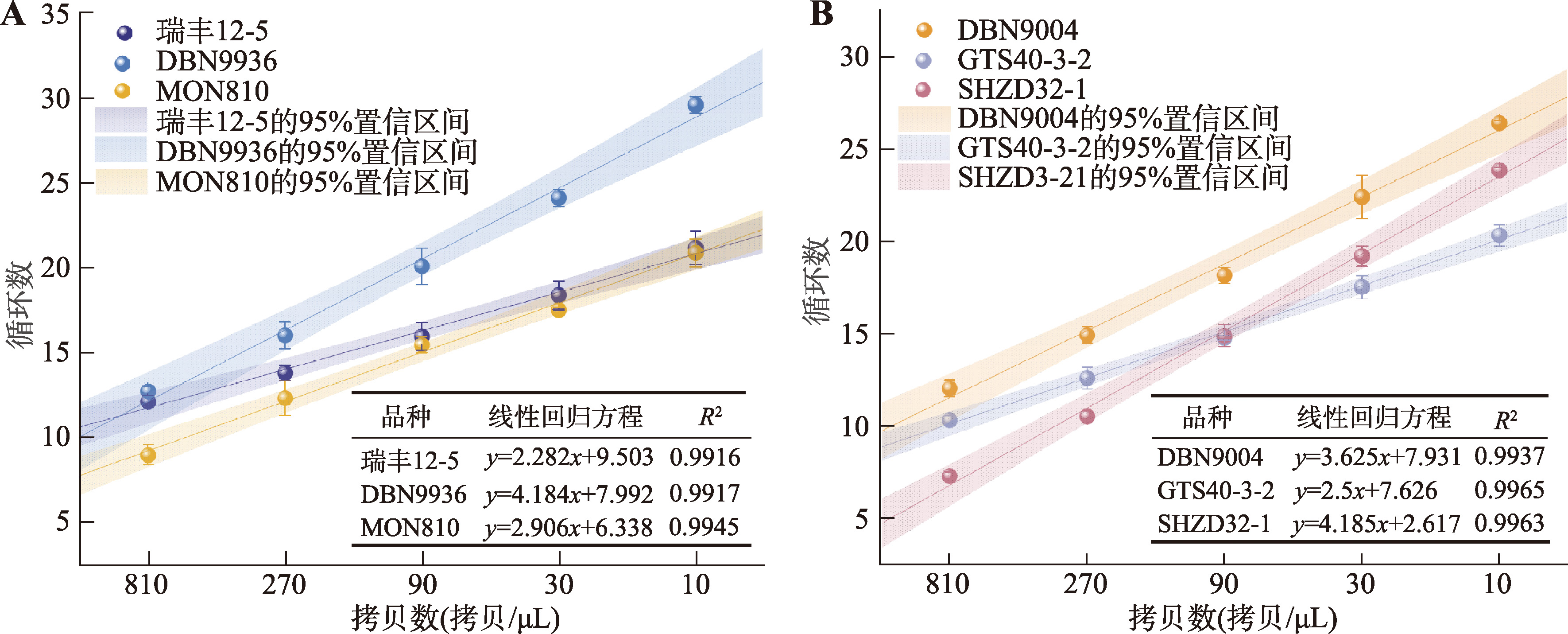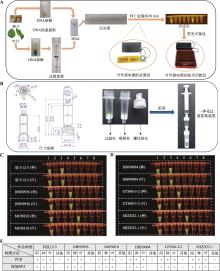Hereditas(Beijing) ›› 2025, Vol. 47 ›› Issue (6): 694-707.doi: 10.16288/j.yczz.24-322
• Technique and Method • Previous Articles
Onsite rapid detection method for genetically modified maize and soybean based on recombinase polymerase amplification
Jiatong Yan1,2( ), Guanwei Chen1,2, Qingmei Miao2, Cheng Peng2, Lei Yang2, Xiaoyun Chen2, Xiaoli Xu2, Wei Wei2, Junfeng Xu2(
), Guanwei Chen1,2, Qingmei Miao2, Cheng Peng2, Lei Yang2, Xiaoyun Chen2, Xiaoli Xu2, Wei Wei2, Junfeng Xu2( ), Xiaofu Wang2(
), Xiaofu Wang2( )
)
- 1. College of Life Science, Zhejiang Normal University, Jinhua 321004, China
2. State Key Laboratory for Quality and Safety of Agro-products, Key Laboratory of Traceability for Agricultural Genetically Modified Organisms, Ministry of Agriculture and Rural Affairs of China, Zhejiang Key Laboratory of Crop Germplasm Innovation and Utilization, Zhejiang Academy of Agricultural Sciences, Hangzhou 310021, China
-
Received:2024-11-07Revised:2024-12-16Online:2025-06-20Published:2025-02-24 -
Contact:Junfeng Xu, Xiaofu Wang E-mail:yjt15150101315@163.com;njjfxu@163.com;yywxf1981@163.com -
Supported by:Zhejiang Province Natural Science Foundation Key Project(LZ23D030001);Major project of Agricultural Biological Breeding(2022ZD0401908);Zhejiang Province Science and Technology Innovation Leading Talent Project(2021R52046)
Cite this article
Jiatong Yan, Guanwei Chen, Qingmei Miao, Cheng Peng, Lei Yang, Xiaoyun Chen, Xiaoli Xu, Wei Wei, Junfeng Xu, Xiaofu Wang. Onsite rapid detection method for genetically modified maize and soybean based on recombinase polymerase amplification[J]. Hereditas(Beijing), 2025, 47(6): 694-707.
share this article
Add to citation manager EndNote|Reference Manager|ProCite|BibTeX|RefWorks
Table 1
Primer sequences and probe sequences used in this study"
| 目的 | 引物名称 | 引物序列(5ʹ→3ʹ) | 参考文献 |
|---|---|---|---|
| 荧光RPA | 12-5-F1 | TCCGACGCCTCGACGCTCGTGGTGACTCGC | 本研究 |
| 12-5-F2 | CGACCAAGTCATGAAGAACTCCCACTGCCG | ||
| 12-5-F3 | CGACCCGAAGATGGAGGCCTACTGCGATGA | ||
| 12-5-F4 | GACGTTCGGTGCCTGGAAGACAAGTTCTAC | ||
| 12-5-F5 | CGTCATCGACCAAGTCATGAAGAACTCCCA | ||
| 12-5-F6 | CAGCTCGTCATCGACCAAGTCATGA | ||
| 12-5-F7 | CCGACGCCTCGACGCTCGTGGTGACTCGCAGC | ||
| 12-5-F8 | CATCGACCAAGTCATGAAGAACTCCCACTGCCG | ||
| 12-5-R1 | ATGCTAGAGCAGCTTGAGCTTGGATCAGAT | ||
| 12-5-R2 | CCGATCGCCCTTCCCAACAGTTGCGCAGCC | ||
| 12-5-R3 | CCAGCTGGCGTAATAGCGAAGAGGCCCGCA | ||
| 12-5-R4 | TAATAGCGAAGAGGCCCGCACCGATCGCCC | ||
| 12-5-R5 | TGAATGGCGAATGCTAGAGCAGCTTGAGCT | ||
| 12-5-R6 | CTGAATGGCGAATGCTAGAGCAGCT | ||
| 12-5-R7 | CTTGAGCTTGGATCAGATTGTCGT TTCCCGCC | ||
| 12-5-R8 | CCCAACAGTTGCGCAGCCTGAATGGCGAATGC | ||
| 12-5-P | AACCACATCGCCCGACGCTACAACGAGAC[FAM-dT][THF]A [BHQ1-dT]AGTTTAAACTGAA[3′-block] | ||
| DBN9936-F1 | TTAAGTTGTCTAAGCGTCAATTGGATCCCG | ||
| DBN9936-F2 | AAACCTAATCAGTCAGTGCCGGTGAGAGCG | ||
| DBN9936-F3 | AAGCGGCCTCGTCAGCCAACACCGTGAGGC | ||
| DBN9936-F4 | AGTCAGTGCCGGTGAGAGCGTAGCTGCCTG | ||
| DBN9936-F5 | TATTAAGTTGTCTAAGCGTCAATTGGATC | ||
| DBN9936-F6 | GGTCCCGTTTAAACCTAATCAGTCAGTGCC | ||
| DBN9936-F7 | GGTGAGAGCGTAGCTGCCTGGAAGCGGCCT | ||
| DBN9936-F8 | GAAGCGGCCTCGTCAGCCAACACCGTGAGG | ||
| DBN9936-R1 | ATATTTATGGGCCATAAACAAGGACCGGCG | ||
| DBN9936-R2 | AATAATCGTCTTGTACTACTGTGCTGAGGG | ||
| DBN9936-R3 | AATAGGAAACAGGAAAGGAGACCCGCGCGC | ||
| DBN9936-R4 | CGTCTTGTACTACTGTGCTGAGGGGCGTGC | ||
| DBN9936-R5 | GCAAATAGGAAACAGGAAAGGAGACCCGCG | ||
| DBN9936-R6 | CAATTGTTTAAAAATAATAATCGTCTTGTA | ||
| DBN9936-R7 | ATAAACAAGGACCGGCGGTCAAGTGAGTGC | ||
| DBN9936-R8 | CATGTCATCCGGAAGCAGGCCGATATTTAT | ||
| DBN9936-P | TATCAGTCAAACGGTCCCGTTTAAACTA[FAM-dT]C[THF]G [BHQ1-dT]GTTTGAAAGCGAG[3′-block] | ||
| MON810-F1 | TCAACGTGCCCGGTACTGGTTCCCTCTGGC | ||
| MON810-F2 | CGCTGAGCGCCCCCAGCCCGATCGGCAAGT | ||
| MON810-F3 | GTGCCCACCACAGCCACCACTTCTCCTTGG | ||
| MON810-F4 | CAGCCACCACTTCTCCTTGGACATCGATGT | ||
| MON810-R1 | GCTGCAGGTGGTCTTACATCTAAGAAGGAT | ||
| MON810-R2 | TTCTCATGATGAAAGCACTAGTACTGCCAA | ||
| MON810-R3 | CAAAAGGACCTGACTGCTCGCAAGCAAATT | ||
| MON810-R4 | GTCTTACATCTAAGAAGGATTCTCATGATG | ||
| MON810-P | CTGCACCGACCTGAACGAGGACTTTCGG[FAM-dT]A[THF]CC [BHQ1-dT]TCTTTCATTTCC[3′-block] | ||
| DBN9004-F1 | TCATGTGTTGAGCATATAAGAAACCCTTAG | ||
| DBN9004-F2 | TTCTAATTCCTAAAACCAAAATCCAGTGGC | ||
| DBN9004-F3 | AACCAAAATCCAGTGGCGCGCCCATGATGG | ||
| DBN9004-F4 | ATGGCCGTATCCGCAATGTGTTATTAAGTT | ||
| DBN9004-R1 | ACTTGATGAAAGAAGAGCGTTGCATTTACG | ||
| DBN9004-R2 | AGAAGAGCGTTGCATTTACGCTCCATAAAC | ||
| DBN9004-R3 | AGAGCGTTGCATTTACGCTCCATAAACGTG | ||
| DBN9004-R4 | TTGATGAAAGAAGAGCGTTGCATTTACGCTCC | ||
| DBN9004-P | GTTGTCTAAGCGTCAATTTGTTTACAAC[FAM-dT]C[THF]G [BHQ1-dT]GACCCCGTAATGA[3′-block] | ||
| GTS40-3-2-F1 | AACCGATGCTAATGAGTTATTTTTGCATGC | ||
| GTS40-3-2-F2 | TCATACATACAGGTTAAAATAAACATAGGG | ||
| GTS40-3-2-F3 | TATTTTTGCATGCTTTAATTTGTTTCTATC | ||
| GTS40-3-2-R1 | ATAGTGGGATTGTGCGTCATCCCTTACGTC | ||
| GTS40-3-2-R2 | TCAGTGGAGATATCACATCAATCCACTTGC | ||
| GTS40-3-2-R3 | TTGCTTTGAAGACGTGGTTGGAACGTCTTC | ||
| GTS40-3-2-R4 | TTCCACGATGCTCCTCGTGGGTGGGGGTCC | ||
| GTS40-3-2-R5 | ACTGTCGGCAGAGGCATCTTGAACGATAGC | ||
| GTS40-3-2-P | CATAGGGAACCCAAATGGAAAAGGAAGG[6FAM-dT]G[THF]C [BHQ1-dT]CCTACAAATGCCA[3′-block] | ||
| SHZD32-1-F1 | CTACACATCCCCTTCCCCCTTCGCTGTTGC | ||
| SHZD32-1-F2 | CCTTCGCTGTTGCAACTCATTGCACAAAGACC | ||
| SHZD32-1-F3 | CAAAGTCACTCATTATTGGAACCCTACACATC | ||
| SHZD32-1-F4 | CGTCTATTTCATTAACTTTAGGATGTTGCTAA | ||
| SHZD32-1-R1 | CTTAGTATGTATTTGTATTTGTAAAATACTTC | ||
| SHZD32-1-R2 | CTTCTATCAATAAAATTTCTAATTCCTAAAAC | ||
| SHZD32-1-R3 | TAAAATTTCTAATTCCTAAAACCAAAATCCAG | ||
| SHZD32-1-R4 | AGGGTTCCTATAGGGTTTCGCTCATGTGTTGA | ||
| SHZD32-1-P | TGTTGCTAAGCACATGCATTTTAACGAA[FAM-dT]T[THF]AT [BHQ1-dT]CGGGGGATCTGG[3′-block] | ||
| 普通PCR | 12-5-F | CAACGTCGTGACTGGGAAAA | [ |
| 12-5-R | TGGAAGACAAGTTCTACGGGCT | ||
| DBN9936-F | CTCGTCAGCCAACACCGTGA | [ | |
| DBN9936-R | CCCCGCCTCATCTTGATCCA | ||
| MON810-F | ACCTCGAGATTTACCTGATCCG | [ | |
| MON810-R | TGCTGCAGGTGGTCTTACATC | ||
| DBN9004-F | CGGGACTTGATGAAAGAAGAG | 待颁布 | |
| DBN9004-R | GGTTTCGCTCATGTGTTGAG | ||
| GTS40-3-2-F | TTCAAACCCTTCAATTTAACCGAT | [ | |
| GTS40-3-2-R | AAGGATAGTGGGATTGTGCGTC | ||
| SHZD32-1-F | GAGCAGCTTGAGCTTGGA | [ | |
| SHZD32-1-R | CGAATTTCACCAAAACACTAA |
| [1] | Li X, Liu P, Liu Q. Review of progress on transgenic animals and transgenic plants and their security. Life Sci Instrum, 2008, 6(1): 9-13. |
| 李霞, 刘鹏, 刘庆. 转基因动、植物的研究进展及其安全性分析. 生命科学仪器, 2008, 6(1): 9-13. | |
| [2] | Herrera-Estrella L, Depicker A, Van Montagu M, Schell J. Expression of chimaeric genes transferred into plant cells using a Ti-plasmid-derived vector. Nature, 1983, 303(5914): 209-213. |
| [3] |
Fraley RT, Rogers SG, Horsch RB, Sanders PR, Flick JS, Adams SP, Bittner ML, Brand LA, Fink CL, Fry JS, Galluppi GR, Goldberg SB, Hoffmann NL, Woo SC. Expression of bacterial genes in plant cells. Proc Natl Acad Sci USA, 1983, 80(15): 4803-4807.
pmid: 6308651 |
| [4] |
Kumar K, Gambhir G, Dass A, Tripathi AK, Singh A, Jha AK, Yadava P, Choudhary M, Rakshit S. Genetically modified crops: current status and future prospects. Planta, 2020, 251(4): 91.
pmid: 32236850 |
| [5] | 国际农业生物技术应用服务组织. 2018年全球生物技术/转基因作物商业化发展态势. 中国生物工程杂志, 2019, 39(8): 1-6. |
| [6] | Li XJ. Development of herbicide tolerant crops and their commercialization in China. Plant Prot, 2023, 49(5): 316-324. |
| 李香菊. 我国耐除草剂转基因作物研发与产业化应用前景. 植物保护, 2023, 49(5): 316-324. | |
| [7] | Liang JG, Xu JF, Jiao Y, Liu PC, Zhang XJ. Research progress and prospect on rapid detection technology of GM crops. Jiangsu Agr Sci, 2019, 47(21): 71-74. |
| 梁晋刚, 徐俊锋, 焦悦, 刘鹏程, 张秀杰. 转基因作物快速检测技术进展与展望. 江苏农业科学, 2019, 47(21): 71-74. | |
| [8] | Li HH, Liu CY, Zhang HW, Wang XJ, Tang QL, Wang YH. Global genetically modified crop industrialization trends in 2022. J Agr Sci Tech, 2023, 25(12): 6-16. |
| 李浩辉, 刘彩月, 张海文, 王旭静, 唐巧玲, 王友华. 2022年度全球转基因作物产业化发展现状及趋势分析. 中国农业科技导报, 2023, 25(12): 6-16. | |
| [9] | 孙眉. 完善配套制度建设有序推进生物育种产业化应用——农业农村部种业管理司、科技教育司负责人就四部部门规章修订答记者问. 中国食品, 2022(4):32-37. |
| [10] | 梦尧, 邹卓瑜, 孟凡军. 转基因作物产业现状及展望. 农业发展与金融, 2024(6):44-46. |
| [11] | Ning CX, Wu LQ. Advancements and future perspectives in transgenic protein detection technology. Metro Sci Technol, 2023, 67(8): 29-35. |
| 宁成香, 武利庆. 转基因蛋白检测技术研究进展与展望. 计量科学与技术, 2023, 67(8): 29-35. | |
| [12] | Li XY, Gao HF, Liu PC, Wang HQ, Liang JG, Zhang XD, Li WL, Zhang XJ. Research progress of rapid detection technology of genetically modified crops. Jiangsu Agr Sci, 2018, 46(3): 5-9. |
| 李夏莹, 高鸿飞, 刘鹏程, 王顥潜, 梁晋刚, 张旭冬, 李文龙, 张秀杰. 转基因作物快速检测技术的研究进展. 江苏农业科学, 2018, 46(3): 5-9. | |
| [13] |
Sánchez-Paniagua LM, Manzanares-Palenzuela CL, López-Ruiz B. Biosensors for GMO testing: nearly 25 years of research. Crit Rev Anal Chem, 2018, 48(5): 391-405.
pmid: 29565638 |
| [14] |
Piepenburg O, Williams CH, Stemple DL, Armes NA. DNA detection using recombination proteins. PLoS Biol, 2006, 4(7): e204.
pmid: 16756388 |
| [15] |
Suther C, Stoufer S, Zhou YJ, Moore MD. Recent developments in isothermal amplification methods for the detection of foodborne viruses. Front Microbiol, 2022, 13: 841875.
pmid: 35308332 |
| [16] | Guan ZW, Qi LJ, Zhang Y, Zhang XJ, Guo ZJ, Du Y. Research progress in application of isothermal nucleic acid amplification technology in food safety. Anal Chem, 2023, 51(7): 1077-1085. |
| 管昭巍, 齐丽娟, 张玉, 张晓军, 郭志军, 杜衍. 等温核酸扩增技术在食品安全中的应用研究进展. 分析化学, 2023, 51(7): 1077-1085. | |
| [17] | Dong ZF, Men YH, Zou QY, Li ZM, Liu ZZ, Ji JW. Application of chlorophyll fluorescence imaging in plant growth environment stress. J Shenyang Agri Univ, 2019, 50(2): 250-256. |
| 董贞芬, 门宇恒, 邹秋滢, 李征明, 刘珍珍, 纪建伟. 叶绿素荧光成像在植物生长环境胁迫中的应用. 沈阳农业大学学报, 2019, 50(2): 250-256. | |
| [18] |
Wang XF, Xie SL, Chen XY, Peng C, Xu XL, Wei W, Ma TF, Cai J, Xu JF. A rapid and convenient method for on-site detection of MON863 maize through real-time fluorescence recombinase polymerase amplification. Food Chem, 2020, 324: 126821.
pmid: 32361093 |
| [19] |
Magriñá Lobato I, O'Sullivan CK. Recombinase polymerase amplification: basics, applications and recent advances. Trends Analyt Chem, 2018, 98: 19-35.
pmid: 32287544 |
| [20] | 农业部2259号公告-12-2015. 转基因植物及其产品成分检测. 抗虫耐除草剂玉米双抗12-5及其衍生品种定性PCR方法. 北京: 中国农业出版社, 2015. |
| [21] | 农业部2630号公告-9-2017. 转基因植物及其产品成分检测. 抗虫耐除草剂玉米C0030.3.5及其衍生品种定性PCR方法. 北京: 中国农业出版社, 2017. |
| [22] | 农业部2122号公告-16-2014. 转基因植物及其产品成分检测. 抗虫玉米MON810及其衍生品种定性PCR方法. 北京: 中国农业出版社, 2014. |
| [23] | 农业农村部公告第323号-10-2020. 转基因植物及其产品成分检测. 耐除草剂大豆GTS40-3-2及其衍生品种定量PCR方法. 北京: 中国农业出版社, 2020. |
| [24] | 农业部2630号公告-15-2017. 转基因植物及其产品成分检测. 耐除草剂大豆SHZD32-1及其衍生品种定性PCR方法. 北京: 中国农业出版社, 2017. |
| [25] |
Xu C, Li L, Jin WJ, Wan YS. Recombinase polymerase amplification (RPA) of CaMV-35S promoter and nos terminator for rapid detection of genetically modified crops. Int J Mol Sci, 2014, 15(10): 18197-18205.
pmid: 25310647 |
| [26] | Liu H, Wang JB, Li P, Bai L, Jia JW, Pan AH, Long XQ, Cui WD, Tang XM. Rapid detection of P-35S and T-nos in genetically modified organisms by recombinase polymerase amplification combined with a lateral flow strip. Food Control, 2020, 107: 106775. |
| [27] | Hu XW, Deng B, Wang JB, Liu H, Tang XY, Wang Y, Zeng HJ, Jiang W, Li H. Rapid detection of CP4-EPSPS transgenic products based on RPA technology. J Agr Sci Tech, 2023, 25(2): 227-233. |
| 胡秀文, 邓波, 王金斌, 刘华, 唐雪明, 王宇, 曾海娟, 蒋玮, 李红. 基于RPA技术对转CP4-EPSPS基因产品的快速检测. 中国农业科技导报, 2023, 25(2): 227-233. |
| [1] | Yu Chen, Xiaoyun Chen, Cheng Peng, Junfeng Xu, Jie Shen, Yueying Li, Xiaofu Wang. Establishment of a field visual detection method for genetically modified maize ‘Shuangkang’12-5 by fluorescence RPA [J]. Hereditas(Beijing), 2021, 43(8): 802-812. |
| [2] | . Unintended effects assessment of genetically modified crops using omics techniques [J]. HEREDITAS, 2013, 35(12): 1360-1367. |
| Viewed | ||||||
|
Full text |
|
|||||
|
Abstract |
|
|||||













